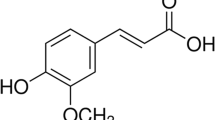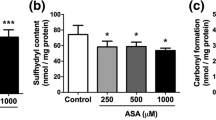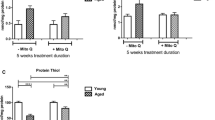Abstract
Brain is extremely susceptible to oxidative damage. Utilizing a series of novel approaches, we have demonstrated that oxidative damage occurs during an ischemia/reperfusion insult (IRI) to brain. Thus, we have demonstrated that an IRI to Mongolian gerbil brain results in: (1) an enhanced rate of salicylate hydroxylation, implicating an increased flux of hydroxyl free radicals; (2) an enhanced flux of free radicals as determined by spintrapping; (3) an enhanced level of endogenous protein oxidation; (4) a decrease in glutamine synthetase (GS) activity, an enzyme very sensitive to oxidative damage; and (5) demonstration of protection from an IRI by administering the spin-trapping agent α-phenyl-tert-butyl nitrone (PBN). The novel observation that PBN offers protection from the lethality brought on by a brain IRI appears to be clearly linked to the ability of the administered spin-trap to inhibit oxidative damage as evidenced by the decreased amount of brain protein oxidation and the prevention of an IRI-mediated loss of GS activity in treated animals. Aged gerbils are more sensitive to the lethal action of a brain IRI than younger animals, but they are protected by PBN administration as are the younger animals. Older gerbils have a significantly higher level of oxidized protein in the brain. Older gerbils have decreased activities of GS and neutral protease, the enzyme that removes oxidized protein, than younger animals. Chronic twice daily administration of PBN (32 mg/kg) for 14 days to older animals significantly lowered brain oxidized protein levels and raised GS and neutral protease activity to those observed in younger animals. Cessation of PBN administration resulted in a time-dependent restoration of protein oxidation levels and enzyme activities back to those observed prior to spin-trap administration. Older gerbils exhibit significantly higher errors in a radial arm maze than younger animals, but older gerbils that had received chronic daily treatments of PBN (32 mg/kg) for 14 days committed significantly less errors than untreated controls. The errors committed in PBN-treated animals was decreased down to the level of those observed in younger animals. Clearly the spin-trapping agent, PBN, appears to have promise in: (1) elucidation of the role of oxidative damage in normal brain function during aging, (2) understanding the development of pathological conditions, and (3) development of treatment regimens for prevention of damage that occurs during the development of pathological conditions and in aging.
Similar content being viewed by others
References
Amici, A., Levine, R.L., Tsai, L., Stadtman, E.R. (1989). Conversion of amino acid residues in proteins and amino acid homopolymers to carbonyl derivatives by metal-catalyzed oxidation reactions. J. Biol. Chem. 264:3341–3346
Brawn, K., Fridovich, I. (1981). DNA strand scission by enzymatically generated oxygen radicals. Arch. Biochem. Biophys. 206:414–419
Cao, W., Carney, J.M., Duchon, A., Floyd, R.A., Chevion, M. (1988). Oxygen free radical involvement in ischemia and reperfusion injury to brain. Neurosci. Lett. 88:233–238
Carney, J.M., Starke-Reed, P.E., Oliver, C.N., Landum, R.W., Chen, M.S., Wu, J.F., Floyd, R.A. (1991). Reversal of age-related increase in brain protein oxidation, decrease in enzyme activity, and loss in temporal and spacial memory by chronic administration of the spin-trapping compoundN-tert-butyl-alpha-phenyl nitrone (PBN). Proc. Natl. Acad. Sci. U.S.A. 88:3633–3636
DeLeo, J.A., Floyd, R.A., Carney, J.M. (1986). Increased in vitro lipid peroxidation of gerbil cerebral cortex as compared with rat. Neurosci. Lett. 67:63–67
Floyd, R.A. (1990). Role of oxygen free radicals in carcinogenesis and brain ischemia. FASEB J. 4:2587–2597
Floyd, R.A., Carney, J.M. (1991). Age influence on oxidative events during brain ischemia/reperfusion. Arch. Gerontol. Geriatr. in press
Floyd, R.A., Watson, J.J. Wong, P.K. (1984). Sensitive assay of hydroxyl free radical formation utilizing high pressure liquid chromatography with electrochemical detection of phenol and salicylate hydroxylation products. J. Biochem. Biophys. Methods 10:221–235
Floyd, R.A., Henderson, R., Watson, J.J., Wong, P.K. (1986). Use of salicylate with high pressure liquid chromatography and electrochemical detection (LCED) as a sensitive measure of hydroxyl free radicals in adriamycin treated rats. J. Free Rad. Biol. Med. 2:13–18
Floyd, R.A., West, M.S., Eneff, K.L., Hogsett, W.E., Tingey, D.T. (1988). Hydroxyl free radical mediated formation of 8-hydroxyguanine in isolated DNA. Arch. Biochem. Biophys. 262(1):266–272
Floyd, R.A., West, M.S., Eneff, K.L., Schneider, J.E., Wong, P.K., Tingey, D.T., Hogsett, W.E. (1990). Conditions influencing yield and analysis of 8-hydroxy-2′-deoxyguanosine in oxidatively damaged DNA. Anal. Biochem. 188:155–158
Hallgren, B., Sourander, P. (1958). The effect of age on the non-haemin iron in the human brain. J. Neurochem. 3:41–51
Janzen, E.G. (1971). Spin trapping. Account Chem. Res. 4:31–40
Lai, E.K., Crossley, C., Sridhar, R., Misra, H.P., Janzen, E.G., McCay, P.B. (1986). In vivo spin-trapping of free radicals generated in brain, spleen, and liver during gamma radiation of mice. Arch. Biochem. Biophys. 244:156–160
Levine, R.L. (1983). Oxidative modification of glutamine synthetase I. Inactivation is due to loss of one histidine residue. J. Biol. Chem. 258:11823–11827
Oliver, C.N., Starke-Reed, P.E., Stadtman, E.R., Liu, G.J., Carney, J.M., Floyd, R.A. (1990). Oxidative damage to brain proteins, loss of glutamine synthetase activity, and production of free radicals during ischemia/reperfusion-induced injury to gerbil brain. Proc. Natl. Acad. Sci. U.S.A. 87:5144–5147
Stadtman, E.R. (1986). Oxidation of proteins by mixed-function oxidation systems: Implications in protein turnover, aging and neutrophil function. Trends Biochem. Sci. 11:11–12
Zaleska, M.M., Floyd, R.A. (1985). Regional lipid peroxidation in rat brain in vitro: Possible role of endogenous iron. Neurochem. Res. 10:397–410
Author information
Authors and Affiliations
Rights and permissions
About this article
Cite this article
Carney, J.M., Floyd, R.A. Protection against oxidative damage to CNS by α-phenyl-tert-butyl nitrone (PBN) and other spin-trapping agents: A novel series of nonlipid free radical scavengers. J Mol Neurosci 3, 47–57 (1991). https://doi.org/10.1007/BF02896848
Issue Date:
DOI: https://doi.org/10.1007/BF02896848




